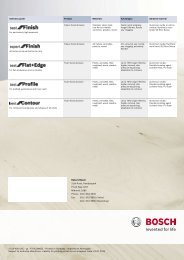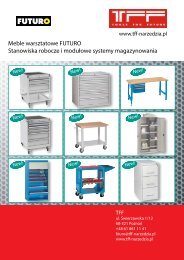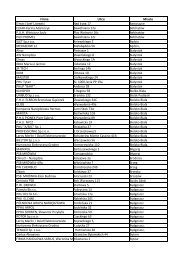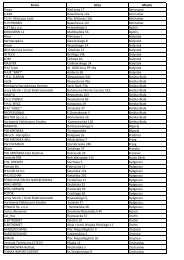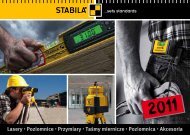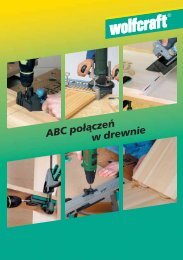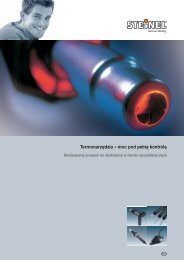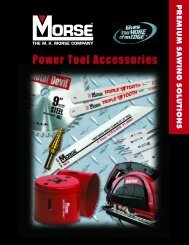RENNSTEIG Striking Tools - portalnarzedzi.pl
RENNSTEIG Striking Tools - portalnarzedzi.pl
RENNSTEIG Striking Tools - portalnarzedzi.pl
Erfolgreiche ePaper selbst erstellen
Machen Sie aus Ihren PDF Publikationen ein blätterbares Flipbook mit unserer einzigartigen Google optimierten e-Paper Software.
Shank Chisels<br />
The <strong>RENNSTEIG</strong> range<br />
of Shank Chisels<br />
The shank chisels made by <strong>RENNSTEIG</strong> serve the<br />
ranges of electric and pneumatic hammers of<br />
almost all important manufacturers.<br />
The tools are used for break and demolition works as<br />
well as general chisel work in industry and at home.<br />
The right selection of shank chisel , correct length<br />
and hammer type guarantee an optimum power<br />
transmission from the hammer via the chisel to the<br />
material to be worked with minimum effort for the<br />
operator.<br />
<strong>RENNSTEIG</strong> shank chisels meet or even exceed<br />
high quality standards. By using high-grade materials<br />
and ap<strong>pl</strong>ying sophisticated technologies for the<br />
manufacture and heat treatment, the shank chisels<br />
are featuring a high serviceability.<br />
Aftertreatment, i.e. regrinding or reforging, can be<br />
done without any problems.<br />
Shank chisels are subject to high stress. In order to<br />
extend the service life of the tools, the below instructions<br />
should be followed<br />
regular and repeated greasing of the shank end to<br />
be fitted into the hammer<br />
avoidance of chisel breaking caused by excessive<br />
space between chisel and the part of the hammer<br />
the chisel is fitted into<br />
selection of correct position towards the working<br />
<strong>pl</strong>ane<br />
avoidance of overheating both at the shank end<br />
and the cutting edge<br />
short impact intervals and gradual treatment of<br />
the material to be worked<br />
regular regrinding of the worn cutting edge<br />
As for health and safety standards and to avert accidents<br />
when working with electric and pneumatic hammers <strong>pl</strong>ease<br />
�����������������������<br />
��<br />
always wear safety goggles (to avoid eye injuries that<br />
might be caused by s<strong>pl</strong>intering material)<br />
short work intervals to not overstrain the wrists<br />
working with a perfect cutting edge in order to prevent<br />
recoils, breaking of the tools as well as to avoid<br />
overstraining of joints<br />
Due to an inevitable wear and tear of the cutting edge when<br />
working with shank chisels, the aftertreatment of the tools is<br />
a matter of great significance.<br />
Acc. to the degree of wear and tear on the cutting edge, two<br />
�������������������������������������������<br />
regrinding<br />
(in case of lower wear and tear of cutting edge )<br />
- in short intervals<br />
- avoid excessive grinding heat in order to avoid<br />
as a consequence reduction of hardness and possible<br />
grinding cracks<br />
- ensure water cooling during regrinding process<br />
reforging<br />
in case of heavy wear and tear by obeying the<br />
� �����������������������<br />
forging<br />
heating of the forging range (cutting edge + 30mm)<br />
up to a forging temperature of 950° to 1050°C<br />
hardening<br />
in accordance with the material used,<br />
heating up to hardening temperature (790° to 880°C)<br />
and immediate quenching in oil afterwards<br />
tempering<br />
heating up to tempering temperature<br />
of approx. 280° C<br />
After heat treatment the cutting edge has to be reground.<br />
Reforging and the subsequent heat treatment should only be<br />
done by trained and experienced peo<strong>pl</strong>e.<br />
���������������������������������



